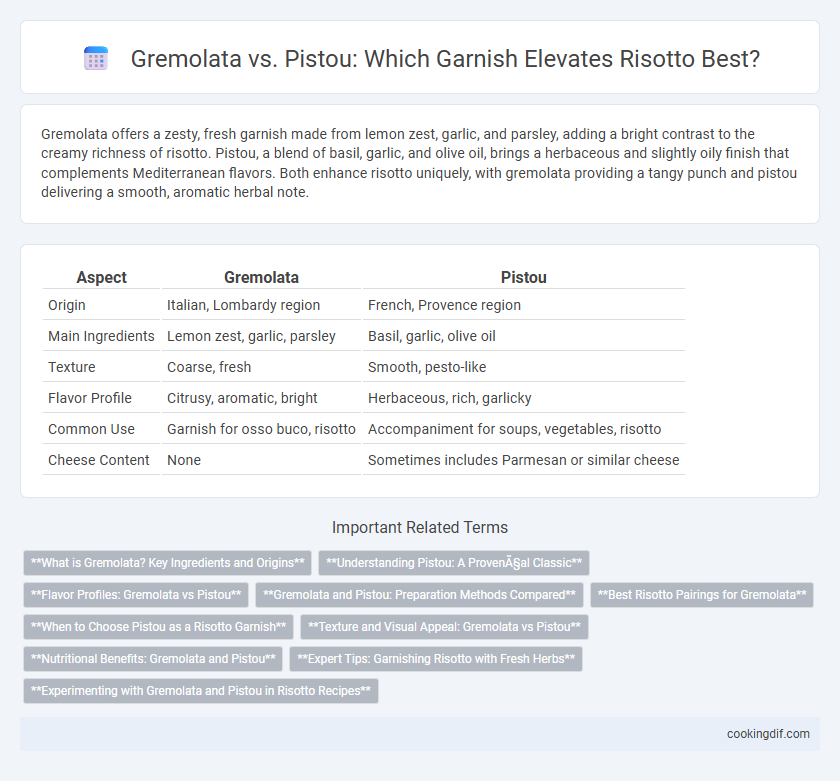Gremolata offers a zesty, fresh garnish made from lemon zest, garlic, and parsley, adding a bright contrast to the creamy richness of risotto. Pistou, a blend of basil, garlic, and olive oil, brings a herbaceous and slightly oily finish that complements Mediterranean flavors. Both enhance risotto uniquely, with gremolata providing a tangy punch and pistou delivering a smooth, aromatic herbal note.
Table of Comparison
| Aspect | Gremolata | Pistou |
|---|---|---|
| Origin | Italian, Lombardy region | French, Provence region |
| Main Ingredients | Lemon zest, garlic, parsley | Basil, garlic, olive oil |
| Texture | Coarse, fresh | Smooth, pesto-like |
| Flavor Profile | Citrusy, aromatic, bright | Herbaceous, rich, garlicky |
| Common Use | Garnish for osso buco, risotto | Accompaniment for soups, vegetables, risotto |
| Cheese Content | None | Sometimes includes Parmesan or similar cheese |
What is Gremolata? Key Ingredients and Origins
Gremolata is a traditional Italian garnish originating from Milan, composed of finely chopped parsley, garlic, and lemon zest, often used to add freshness and brightness to rich dishes like osso buco or risotto. Its key ingredients--parsley, garlic, and lemon zest--provide a zesty, aromatic contrast that enhances the dish's flavors without overpowering them. Unlike pistou, which includes basil, pine nuts, and olive oil, gremolata remains a simple, herbaceous topping rooted in Italian culinary traditions.
Understanding Pistou: A Provençal Classic
Pistou, a Provencal classic, is a vibrant garnish made primarily from fresh basil, garlic, and olive oil, sometimes enriched with grated cheese like Parmesan to enhance its rich, aromatic flavor. Unlike gremolata, which combines lemon zest, garlic, and parsley, pistou provides a creamy, herbaceous note that complements the creamy texture of risotto without overwhelming it. Its Mediterranean roots bring a subtle, fragrant freshness that elevates the dish with a nuanced balance of herbal and savory elements.
Flavor Profiles: Gremolata vs Pistou
Gremolata offers a bright, zesty flavor with fresh parsley, garlic, and lemon zest that adds a vibrant Citrus note to risotto. Pistou provides a rich, herbaceous taste with basil, garlic, and olive oil, lending a creamy and slightly nutty depth without the acidity. Choosing between gremolata and pistou depends on whether you prefer a fresh, tangy garnish or a smooth, fragrant herb flavor to complement the creamy texture of risotto.
Gremolata and Pistou: Preparation Methods Compared
Gremolata is prepared by finely chopping fresh parsley, garlic, and lemon zest, creating a bright and zesty topping often sprinkled over risotto for a burst of freshness. Pistou, originating from Provencal cuisine, combines crushed garlic, fresh basil leaves, and olive oil, resembling a simpler version of pesto without nuts or cheese, adding a rich, herbaceous flavor to the dish. Both garnishes enhance risotto by introducing vibrant herbal notes, but gremolata offers a more citrusy sharpness, while pistou provides a smooth, aromatic depth.
Best Risotto Pairings for Gremolata
Gremolata, a zesty blend of lemon zest, garlic, and parsley, perfectly complements risottos featuring rich, earthy ingredients like mushroom or braised meats by adding a fresh, vibrant contrast. Its bright citrus notes elevate creamy risotto dishes, balancing the richness while enhancing flavors without overpowering the dish. For optimal risotto pairings, use gremolata with beef, veal, or mushroom risottos to create a harmonious flavor profile that intensifies the overall dining experience.
When to Choose Pistou as a Risotto Garnish
Pistou is ideal as a risotto garnish when seeking a rich, herbaceous flavor with a creamy texture derived from fresh basil, garlic, and olive oil, sometimes enhanced with pine nuts or cheese. Its smooth consistency blends well with creamy risottos, complementing dishes featuring vegetables or seafood. Choose pistou for a Mediterranean twist that intensifies the dish's freshness without overpowering the delicate rice flavors.
Texture and Visual Appeal: Gremolata vs Pistou
Gremolata offers a bright, coarse texture with finely chopped parsley, garlic, and lemon zest that adds a vibrant color contrast and a refreshing crunch atop risotto. Pistou, made from blended basil, garlic, and olive oil, provides a smooth, creamy consistency that melts gently into the risotto, delivering a rich green hue without disrupting the dish's soft texture. The choice between gremolata and pistou significantly influences both the tactile experience and visual presentation of risotto, enhancing its appeal depending on the desired texture intensity and aesthetic effect.
Nutritional Benefits: Gremolata and Pistou
Gremolata, made from fresh parsley, garlic, and lemon zest, is rich in antioxidants, vitamin C, and fiber, supporting immune health and digestion. Pistou, a blend of basil, garlic, and olive oil, offers heart-healthy monounsaturated fats, vitamin K, and anti-inflammatory properties. Both garnishes enhance risotto's flavor while contributing essential nutrients that promote overall wellness.
Expert Tips: Garnishing Risotto with Fresh Herbs
Gremolata, a zesty mix of lemon zest, garlic, and parsley, adds a bright, citrusy contrast that enhances the creamy texture of risotto without overpowering its delicate flavors. Pistou, made from fresh basil, garlic, and olive oil, offers a rich, herbaceous note that intensifies the risotto's savory depth, especially in vegetable or tomato-based variations. Expert chefs recommend choosing gremolata for light, seafood risottos and pistou for heartier, vegetable-forward dishes to achieve optimal flavor balance and fresh herb vibrancy.
Experimenting with Gremolata and Pistou in Risotto Recipes
Experimenting with gremolata and pistou in risotto recipes introduces distinct flavor profiles that elevate the dish's complexity. Gremolata, made from lemon zest, garlic, and parsley, adds a bright, citrusy freshness that cuts through the creaminess of risotto. Pistou, a Provencal blend of basil, garlic, and olive oil, imparts a rich, herbaceous depth that complements mushroom or tomato-based risottos perfectly.
Gremolata vs Pistou for garnish Infographic

 cookingdif.com
cookingdif.com